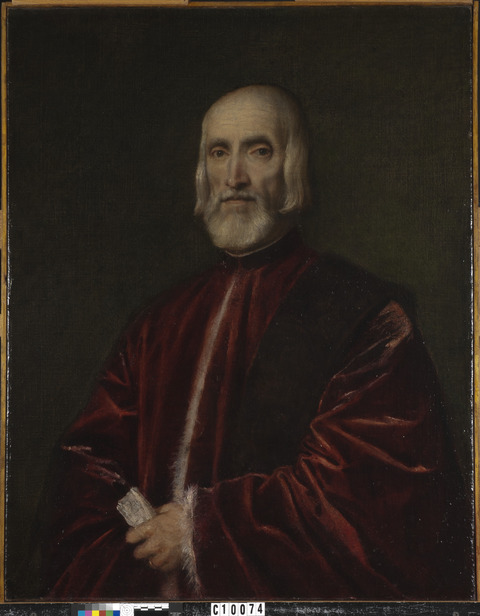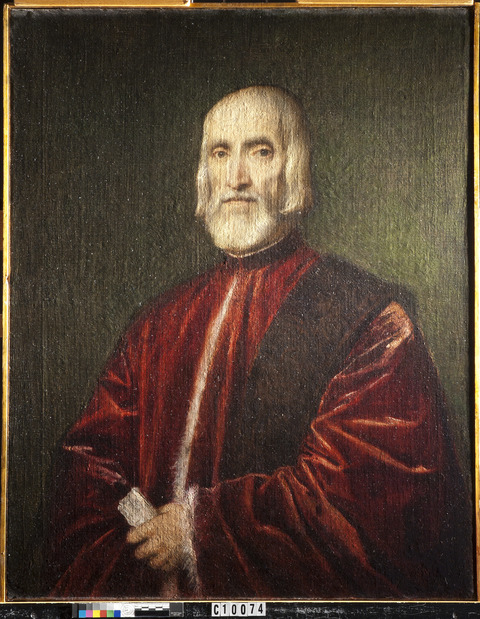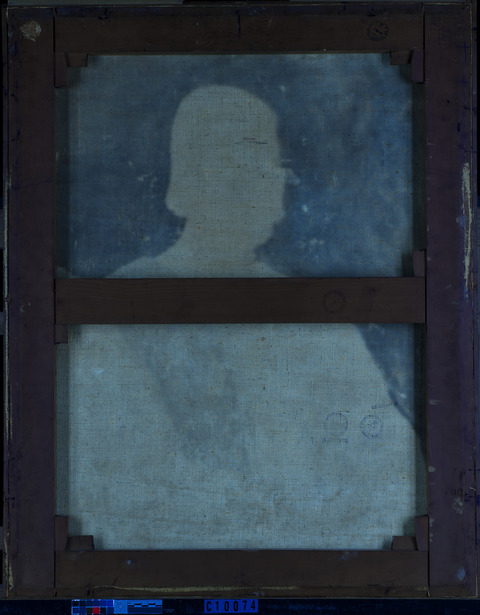Overview
Accession number: 2016.166
Artist: Workshop of Titian
Title: Portrait of Andrea de’ Franceschi
Materials: Oil (untested) on canvas.
Date of creation: About 1550
Previous number/accession number: C10074
Dimensions:
86.8 cm × 68.2 cm
Conservator/examiner: Fiona Beckett
Examination completed: 2014
Distinguishing Marks
Front:
None
Back:
Item 1. Circular customs stamp, green-blue, back, upper stretcher bar: “DOGANA FIRENZE NO 6 2 AGO3 28” (tech. fig. 1).
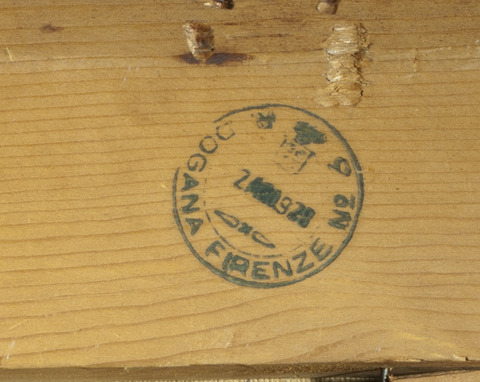
Item 2. Circular stamp, blue, back, upper half of lining canvas, illegible (tech. fig. 2).
Item 3. Circular stamp, blue, back, upper half of lining canvas, illegible (tech. fig. 2).
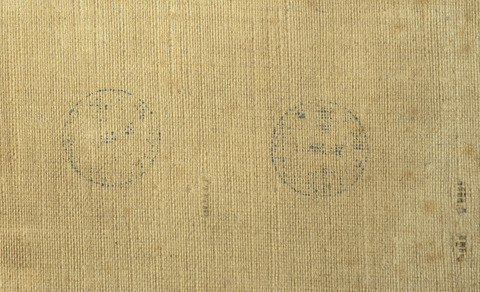
Item 4. Circular customs stamp, purple-gray, crossbar: “_______ESPORTAZIONE DI __DETTI DI ANTICHITA' E D’ARTE FIRENZE” and “1 AGOSTO 1931” (tech. fig. 3).
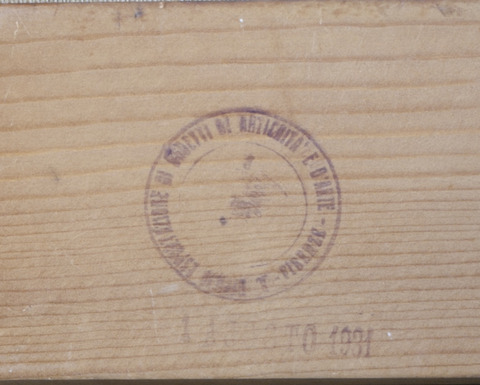
Item 5. Circular stamp, purple, back, lower half of lining canvas, illegible, “1 AGOSTO 1931” (tech. fig. 4).
Item 6. Circular stamp, blue, back, lower half of lining canvas: “UFFICIO ESPORTAZIONE_____D’ARTE_____” and “22 AGOSTO 1928” (tech. fig. 4).
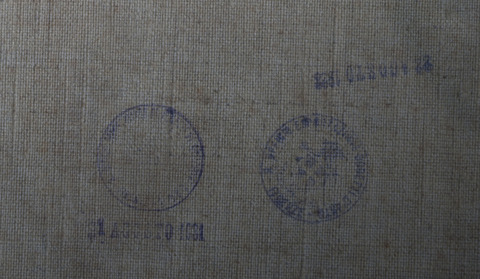
Summary of Treatment History
Physical as well as documentary evidence suggests that the painting has undergone several conservation campaigns. Documentation on file at the IMA indicates that the painting was in William Suhr’s studio from 24 January to 23 June 1955, and that it was also treated by him in 1960. A letter on file states the following: “There exists a weakness in the bond between the support, in this case canvas, the ground and the paint film, which causes the flaking which has plagued us twice before. I will have to take off the varnish, fasten all loose paint, and attenuate the few losses, and then re-varnish the painting” (tech. figs. 5, 6).1
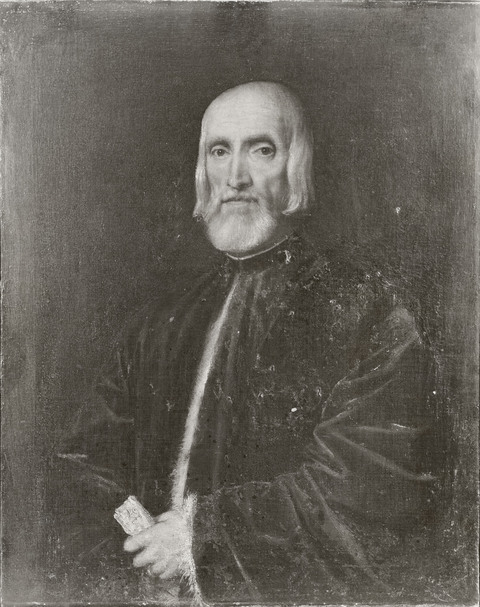
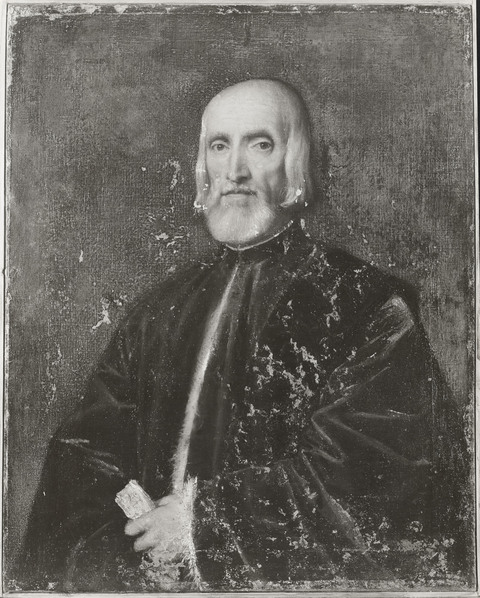
A treatment was proposed in 1964 by Daniel Goldreyer in a letter: “The painting will be faced with facing tissue, old relining canvas and glue will be removed, the painting will be double relined on Irish linen, re-stretched on a new custom made stretcher, cleaned filled and inpainted only where necessary and varnished in semi matte finish. For additional protection, the edges will be bound with fiber paper and keys wired in."2 This treatment was paid for by the IMA and was either undone or modified from the initial proposal, perhaps in 1974, as the painting has a single nineteenth- or early twentieth-century glue lining, and no brown liner tape or wired-in keys. Additionally, the customs stamps on the back (tech. figs. 1–4) dating to 1928 and 1931 (see Distinguishing Marks) would no longer be present if the treatment as described had occurred.
Documentation records a series of condition assessments and treatments that were carried out on the collection around the time the works were moved from the Clowes residence to the IMA in 1971. A condition report by Paul Spheeris in October of that year, likely carried out before the paintings were relocated, described the painting as “O.K” but noted a chip to the frame. He recommended cleaning the painting for the sake of appearance but not for the safety of the work.3 A second condition assessment was carried out upon arrival of the paintings at the IMA. This assessment describes the work as in good condition, and no work was deemed necessary.4
In 1974, a condition assessment, treatment, and investigation of the collection was carried out by the Intermuseum Conservation Association at Oberlin College. This document describes this painting as having a “heavy natural resin varnish which has discolored” and “grime in interstices.” The removal of surface coating, overpaint, relining, and inpainting were recommended.5 A memorandum explaining the charges for this work suggest the recommended work was indeed carried out.6 In 1996, a memorandum summarizing treatment and examination of the Clowes Collection from the time it entered the collection suggests that in 1987 the painting was examined, surface cleaned, and varnished.7
The painting was examined and documented in the Clowes Collection annual survey from 2011 to 2020.
Current Condition Summary
Aesthetically, it is clear the painting suffered significantly in the past, with areas of original paint and ground missing. This is partially visible in the texture of the surface. Many abraded areas have been extensively restored. The painting is sound structurally, with the glue lining intact.
Methods of Examination, Imaging, and Analysis
| Examination/Imaging | Analysis (no sample required) | Analysis (sample required) |
|---|---|---|
| Unaided eye | Dendrochronology | Microchemical analysis |
| Optical microscopy | Wood identification | Fiber ID |
| Incident light | Microchemical analysis | Cross-section sampling |
| Raking light | Thread count analysis | Dispersed pigment sample |
| Reflected/specular light | X-ray fluorescence spectroscopy (XRF) | Fourier-transform infrared spectroscopy (FTIR) |
| Transmitted light | Macro X-ray fluorescence scanning (MA-XRF) | Raman microspectroscopy |
| Ultraviolet-induced visible fluorescence (UV) | ||
| Infrared reflectography (IRR) | Gas chromatography–mass spectrometry (GC-MS) | |
| Infrared transmittography (IRT) | Scanning electron microscope -energy dispersive X-ray spectroscopy (SEM-EDS) | |
| Infrared luminescence | Other: | |
| X-radiography |
Technical Examination
Description of Support
Analyzed Observed
Material (fabric, wood, metal, dendrochronology results, fiber ID information, etc.):
The support appears to be a plain-weave linen canvas. It is finely woven, with a thread count of 20 × 20 threads/cm. The lining canvas is a more thickly woven canvas with a thread count of 11 × 14 threads/cm2.
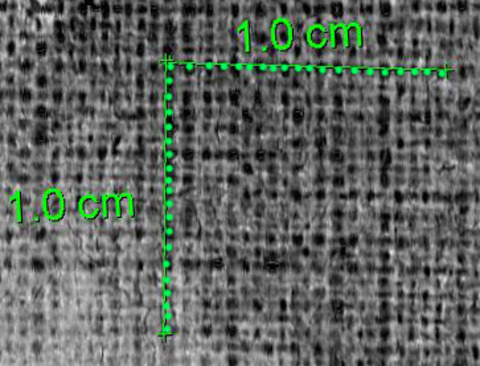
Characteristics of Construction / Fabrication (cusping, beveled edges of panels, seams, joins, battens):
Cusping is visible on all four edges (see tech. fig. 8), indicating that the painting is close to its original size. The tacking margins were trimmed but not entirely removed, a process which likely occurred at the time the painting was lined (or during a previous treatment campaign). From the damage visible on the X-radiograph, it appears as though the painting may have been resized to fit a smaller stretcher. Lines along all four edges, together with loss of ground and paint layers in these areas indicate the folding edge. This was later reincorporated into the current composition during a later conservation campaign, so that the painting is now closer to its original size.
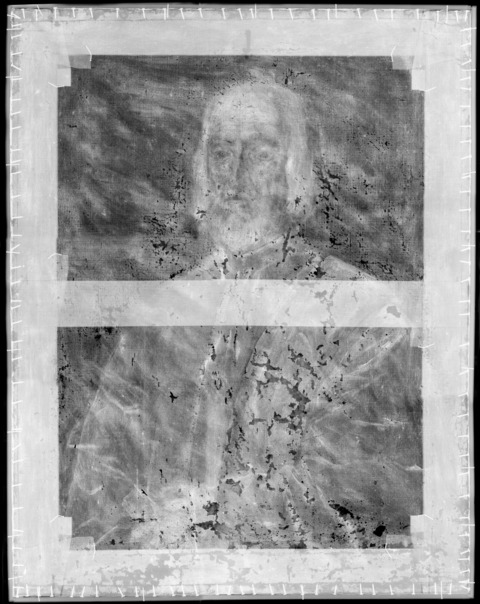
Thickness (for panels or boards):
N/A
Production/Dealer’s marks:
See Distinguishing Marks for customs stamps on both the stretcher and the lining canvas.
Auxiliary Support:
Original Not original Not able to discern None
Attachment to Auxiliary Support:
The auxiliary support is a five-member simple mortise and tenon stretcher with interlocking keys, consistent with that reported in Italian mid-nineteenth-century stretchers.8 The four outer members are not beveled or beaded and the canvas rests flush against the wood. The crossbar is set in at a distance of approximately 0.9 cm and does not touch the canvas. When the painting is vertical, the clearance from the crossbar to the canvas is 0.8 cm. This was measured at a 50% relative humidity and may fluctuate slightly if the humidity levels change. The stretcher has been keyed out, and the keys are held in place with tacks. The lining canvas and what remains of the original tacking margins are secured to the stretcher with a large number of tacks on all four sides, as evident in the X-radiograph. Additionally, 10 of 10 keys are present.
Condition of Support
The support is in stable condition, with good adhesion between the original canvas and the lining canvas. The back of the lining canvas bears a stain resembling the shape of the sitter on the front (tech. fig. 9). This may be due to the application of a previous varnish (a colored varnish could account for the reddish and greenish tints) that saturated through to the underlying lining canvas. The varnish may have been applied in a selective manner to cause such a stain, or the paint layers on the face and torso were more intact so as to prevent the varnish from passing through the canvas weave. The canvas is in plane and well attached to the stretcher. The tacking margins are not fully visible due to the addition of edge strips. However, where the original tacking margins are visible, they appear to be in good condition. The lining canvas is also in good condition. The stretcher bars are not beveled or beaded, allowing the canvas to come into contact with the stretcher bar and causing visible stretcher bar marks on the front surface. The stretcher bar marks are not prominent due to the stiff glue lining but may worsen over time as the canvas comes into contact with the bars with the slightest movement.
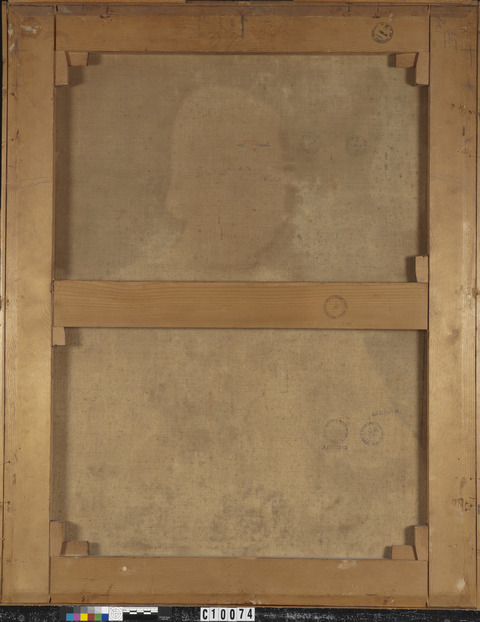
Description of Ground
Analyzed Observed
Materials/Binding Medium:
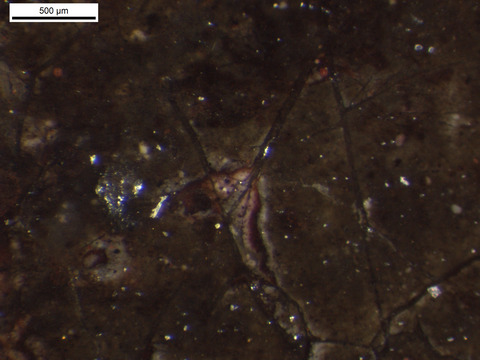
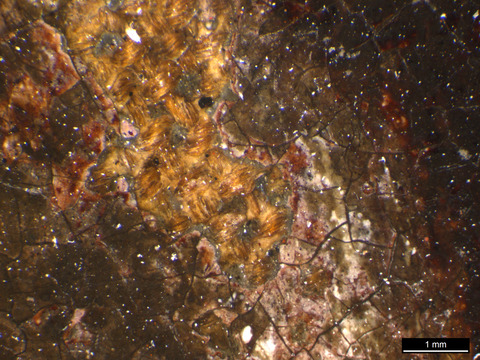
The ground has been identified as calcium sulfate using EDS analysis (tech. figs. 13, 14). Calcium sulfate, or gesso, was commonly used by Italian artists of the late fifteenth and early sixteenth centuries, including Titian.9 The calcium sulfate would have been mixed with animal glue before application. A gray imprimatura, composed of pigments such as umber and bone black, was present in some areas. Although not visible in all cross sections, the lead white-rich imprimatura is visible in cross section 1 (tech. fig. 21). XRF analysis (see table 1) reveals high levels of lead throughout the painting, and the X-radiograph reveals dense brushwork in the background that suggests a more widespread application of a lead-white imprimatura.
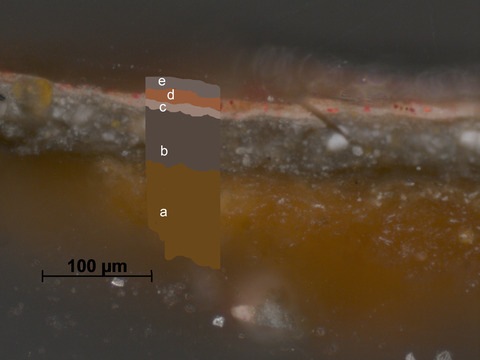
Color:
White ground, with some areas of the background appearing pale gray, likely due to the imprimatura layer.
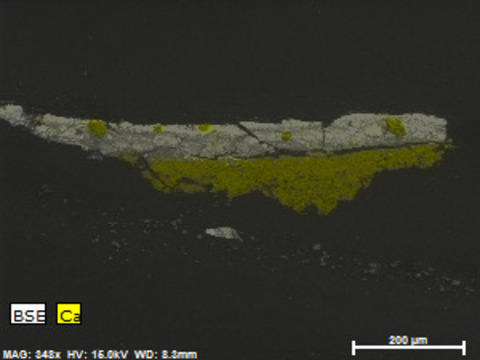
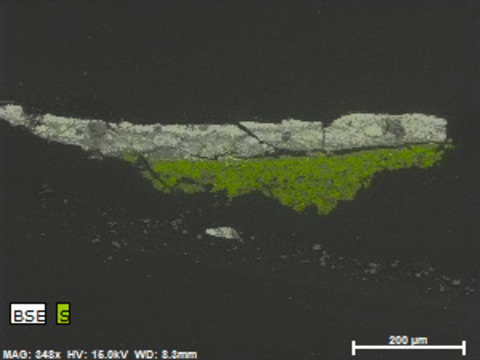
Application:
The white ground is very thinly applied and where visible appears to be scraped over the canvas, likely with a palette knife. The imprimatura appears to be brush applied and it is visible in the X-radiograph as sweeping brushwork around the figure.
Thickness:
The white calcium layer is very thin in some areas (as seen in areas of loss) but likely varies, as the cross section revealed variation of thickness between 50-150µm.
Sizing:
Though not discernible, animal-glue size would have been applied to the canvas prior to the ground layer.
Character and Appearance (Does texture of support remain detectable / prominent?):
The texture of the canvas and lining canvas are visible through the ground and paint layers and remains prominent. The lining canvas has caused a weave interference pattern, which detracts visually from the composition of the painting. The original canvas is more finely woven than the weave texture on the surface appears.
Condition of Ground
Where visible, the ground appears to be in stable condition and well adhered to the canvas and paint layers. Previous damage to the ground layer has resulted in several areas of filling primarily in the sitter’s hand, garments, and the background. A cracking network is present throughout the painting and originates in the ground layer due to the movement of the canvas in response to environmental shifts over time.
Description of Composition Planning
Methods of Analysis:
Surface observation (unaided or with magnification)
Infrared reflectography (IRR)
X-radiography
Analysis Parameters:
| X-radiography equipment | GE Inspection Technologies Type: ERESCO 200MFR 3.1, Tube S/N: MIR 201E 58-2812, EN 12543: 1.0mm, Filter: 0.8mm Be + 2mm Al |
|---|---|
| KV: | 20 |
| mA: | 3 |
| Exposure time (s) | 90 |
| Distance from X-ray tube: | 36” |
| IRR equipment and wavelength | Opus Instruments Osiris A1 infrared camera with InGaAs array detector operating at a wavelength of 0.9-1.7µm. |
Medium/Technique:
The underdrawing appears to be a fluid carbon-containing medium, possibly part of the painting process.
Pentimenti:
No pentiments are discernible. In some areas, underdrawing can be seen in the infrared reflectogram (tech. fig. 15). Rough outlining around the head, the hand, and the edges of the robe appear as adjustments and refinements made to the composition during the painting process. The underdrawing appears to be done in a fluid medium, likely a carbon-based ink or paint, based on its reflectance in the infrared region of the spectrum. Although none was observed visually, there may be additional underdrawing in a material not captured by the Osiris camera, such as red or white chalk.
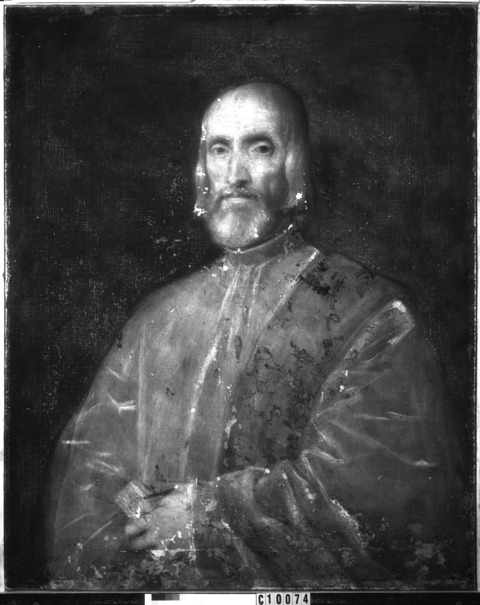
Description of Paint
Analyzed Observed
The painting is a portrait of Andrea de' Franceschi, a well-known grand chancellor of Venice. Titian painted the sitter on several occasions, and they were also good friends. The Clowes portrait is thought to be painted in the chancellor’s last decade of life, as indicated in the curatorial file at the IMA. Andrea de' Franceschi died at age 80, in 1551. Many of the portraits of him are similar in their composition and the way in which the sitter is positioned as well as his expression (tech. figs. 16–18).
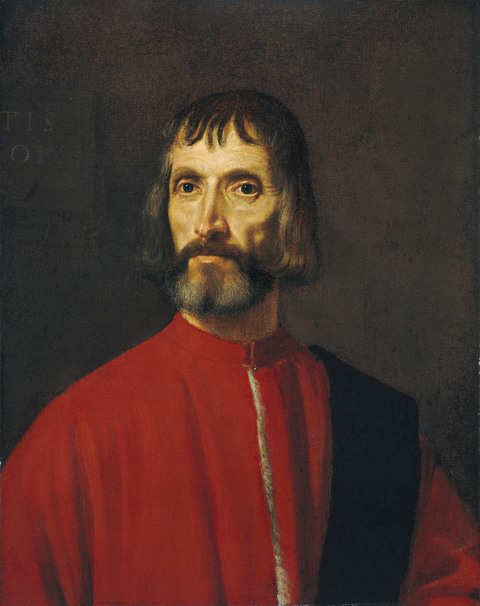

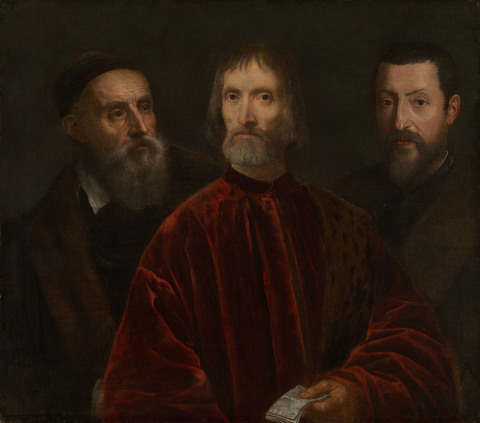
Application and Technique:
The paint layer has been roughly applied with large brushstrokes. More details are visible in the face than in the garments. The letter in the sitter’s proper left hand once had fine writing but is now illegible. Much of the painting technique incorporates the use of glazes. The red folding drapery of the sitter’s attire was worked up in a layering technique of red glazes interspersed with white layers and coated with a final transparent red glaze to create sumptuous optical effects of the velvet. This is also visible in two cross sections (tech. fig. 19) from samples that were taken: sample 2 from the hand area and sample 3 from the proper right shoulder.
Cross-Section Analysis:
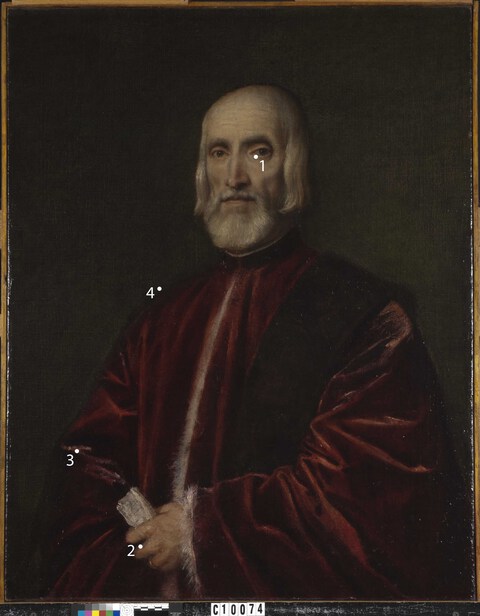
Cross sections were taken from four areas of the painting located near existing damages to help determine the layer structure, identify the ground and paint layers including specific use of pigment, and compare the results to already existing data on Titian’s practice.10
Four cross sections were taken from areas of the painting that would provide useful information. The locations are shown in technical figure 19. The cross sections were then mounted in bioplastic and sanded for analysis. Methods of analysis include optical microscopy in both normal illumination and ultraviolet irradiation for all samples. Raman microspectroscopy was used to analyze pigments in cross sections 3 and 4. SEM-EDS was used to analyze cross section 1. The results as they relate to each cross section are described in more detail below.
Cross Section 1:
Cross section 1 (tech. figs. 20-21) was taken from underneath the proper left eye in an area of cracking and reveals the layering structure used in a critical and important part of the painting that would have been given additional attention as the face captures the likeness of the sitter. The cross section shows: a) the ground layer which appears yellowed from age and previous restoration efforts; b) a gray imprimatura layer; c) and d) two thin paint layers of skin tones; and e) an upper discolored varnish layer.

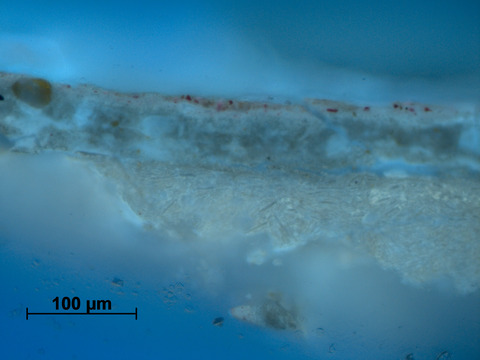
The cross section was analyzed by SEM-EDS to determine the elemental composition of the layers and especially to determine the composition of the ground layer, since it would provide results which could be compared to Titian’s other works as well as availability of the materials during the time in which Titian worked. The results from SEM-EDS reveal that the ground layer is composed of calcium and sulfur, indicating a calcium sulfate (gesso) ground (likely mixed with animal glue). A considerable amount of lead is present in all subsequent layers (see tech. fig. 22).
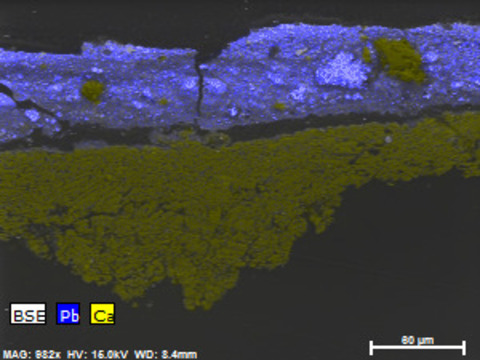
Cross Section 2:
Cross section 2 (tech. figs. 23, 24) was taken from a crack in the hand of the sitter in an area where possible adjustment could exist, as dictated by the infrared image. The cross section reveals the layer structure used where the hand and drapery overlap and reveals the red and white layering system used by the artist to achieve the look of rich velvet. A large particle of yellow was present in the imprimatura layer (tech. fig. 23), which does not contain any black pigment in this particular sample, indicating it may not be a uniform gray imprimatura over the entire canvas, but slightly varied. The yellow particle was analyzed by Raman microspectroscopy, which revealed that it was yellow ochre. Being only a single large pigment particle, its presence in the imprimatura could indicate some variations in composition or it could simply be a wayward contaminant.
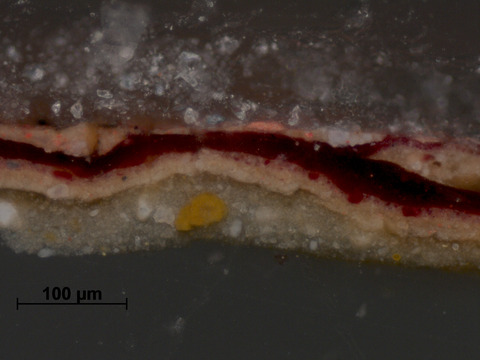
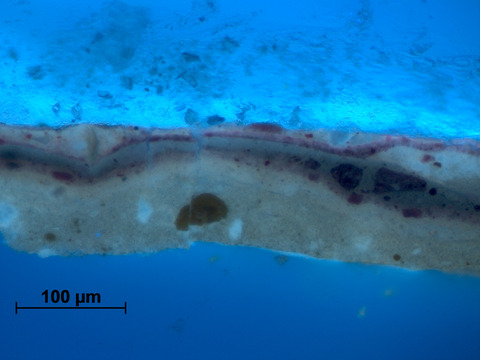
Cross Section 3:
Cross section 3 (tech. figs. 25, 26) was taken from the edge of an area of loss in the proper right sleeve to better understand the layers built in the cloak drapery and in the forming of the drapery folds. The cross section revealed a similar buildup of layers as cross section 2 of the hand. The red is void of distinct particles of pigment, indicating it is most likely an organic red lake applied as a glaze, such as kermes or cochineal red. The white appears to be lead white.
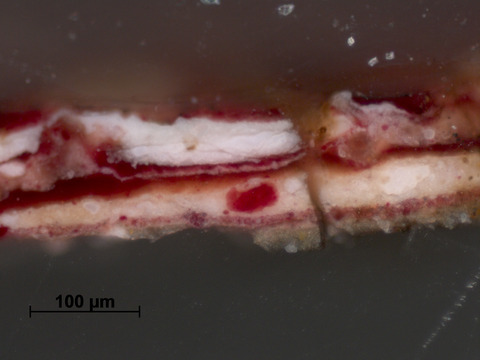
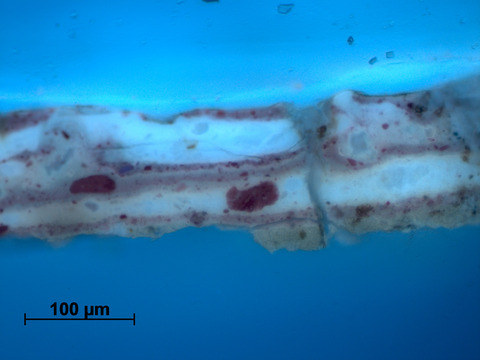
Cross Section 4:
Cross section 4 (tech. figs. 27, 28) was taken from the edge of a crack in the green-red interface located along the upper proper right shoulder where there was also likelihood of some outlining of the figure. The sample unfortunately shattered due to the small sample size and the brittle nature of the paint. Rather than causing more damage by taking an additional cross section, the small particles were mounted in resin and examined separately. The green and black sample was the most interesting and provided the most information. The green in the sample appears free of distinct particles and resembles a glaze. It was analyzed via Raman microspectroscopy. The result indicated a copper resinate, used between the fifteenth and seventeenth centuries. Typically, copper resinate oxidizes and turns brown over time. The presence of the copper resinate with an emerald-like appearance indicates that at least some of the painting’s glaze remains intact, likely from being covered with other paint. Likely this was an anomaly and the glaze over much of the painting’s background would have oxidized, causing the painting to appear slightly more brown-toned than it would have appeared when it was originally painted. The black pigment in the sample was also analyzed by Raman microspectroscopy and was found to be a carbon-containing black, such as lamp black. As this sample was deliberately taken in an area of outlining related to the underdrawing, it is possible that this black comprises the underdrawing. Given that the sample is so small, no conclusions about the underdrawing as a whole can be drawn.
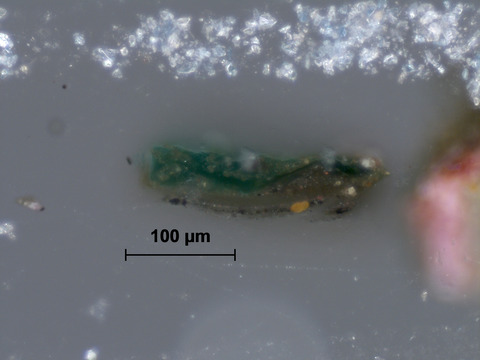
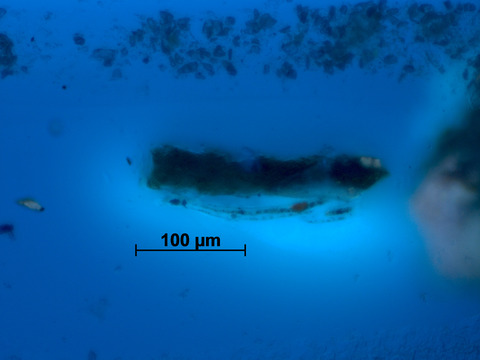
Painting Tools:
Brushes of varying sizes, no evidence of palette knife or other hard-edged tools were used in the application of the upper paint layers.
Binding Media:
Oil (untested)
Color Palette:
The color palette is simple, consisting of reds, greens, and skin tones, with white and black for highlighting and shadowing. Results from XRF, Raman microspectroscopy, and SEM-EDS analysis indicate the presence of several pigments commonly used in late fifteenth- to early sixteenth-century Italian painting, including lead white, vermilion, red earth, iron oxide (earth pigments including yellow ochre), copper resinate, umber, and bone black. Red lake glazes were also used in the robes of the sitter. The strong peak for calcium in XRF (table 1, sample 5) suggests the presence of a red lake with a calcium substrate especially given that no vermilion was detected in this location. However, XRF analysis is not the best mode of identification for lake pigments due to their containing primarily organic elements. This layer can be seen in cross sections 2 and 3 (tech. figs. 23, 25).
Additionally, there is a significant amount of inpainting that would have been added during the restoration campaigns. These campaigns account for the presence of later pigments such as zinc white, titanium white, and cadmium-containing colors.
XRF Analysis:
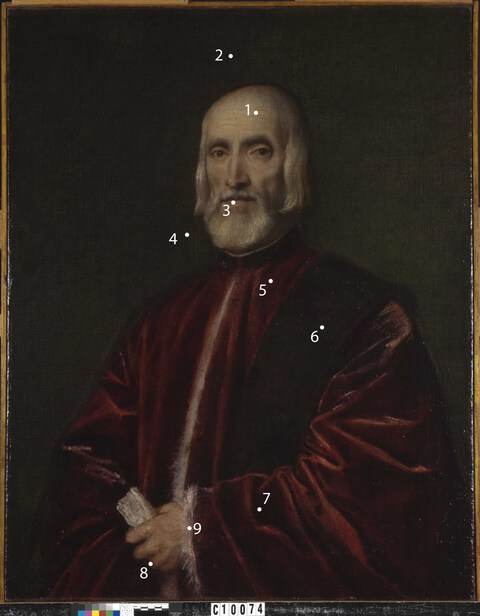
| Sample | Location (x, y) | Elements | Possible Pigments |
|---|---|---|---|
| 1 | Skin tone, forehead (40, 2.5 cm) | Major: Pb Minor: Hg, Fe Trace: Ca, Ti, Mn | Lead white, vermilion, iron oxide (earth pigments including umber), calcium (likely from ground layer). |
| 2 | Green background (24, 7 cm) | Major: Pb, Ca, Cu, Fe Minor: Zn, Mn, Ti Trace: Sr, Cd | Lead white, calcium (likely from ground layer), copper-containing green pigment (likely malachite or verdigris), iron oxide (earth pigments including umber), titanium (from iron oxide impurity or from titanium white retouching), zinc white from retouching, cadmium-containing pigments from retouching. |
| 3 | Red in lips (4.1, 15 cm) | Major: Pb, Hg, Fe Minor: Ca, Cu, Mn Trace: Ti | Lead white, vermilion, iron oxide (earth pigments including umber), copper-containing green pigment, calcium (likely from ground layer). |
| 4 | Green background left of face (7.2, 12.5 cm) | Major: Pb, Ca, Cu, Fe Minor: Mn, Ti, Trace: Sr, Zn | Lead white, calcium (likely from ground), copper-containing green pigment (likely malachite or verdigris), iron oxide (earth pigments including umber), trace of zinc white from retouching. |
| 5 | Red robe near neck (10, 31cm) | Major: Pb, Ca, Fe Minor: Cu Trace: Ti, Mn, Zn, Cd | Lead white, calcium (likely from ground layer and possibly from the substrate for red lake pigment), iron oxide (earth pigments including umber), copper-containing green pigment, trace of zinc white from retouching, trace of cadmium-containing pigments from retouching. |
| 6 | Black sash (23, 31 cm) | Major: Pb, Cu, Fe, Ca Minor: Ti, Mn, P Trace: K | Lead white, copper-containing green pigment, bone black, iron oxide (earth pigments including umber), calcium (likely from ground layer). |
| 7 | Red on sleeve (28, 31 cm) | Major: Pb, Ca, Ti Minor: Fe, Cu, K Trace: P, Mn, Zn, Cd | Lead white, bone black, calcium (likely from ground layer and possibly from the substrate for red lake pigment), iron oxide (earth pigments including umber), copper-containing green pigment, titanium white (from retouching), trace of zinc white from retouching, trace of cadmium-containing pigments from retouching. |
| 8 | Yellow ring (45, 55 cm) | Major: Pb, Fe Minor: Ca, Trace: Hg, Ti, Mn, Cu, Zn | Lead white, iron oxide (earth pigments including yellow ocher and umber), calcium (likely from ground layer), trace of copper-containing green pigment, trace of vermillion, trace of zinc white from retouching. |
| 9 | White fur sleeve (28, 56 cm) | Major: Pb Minor: Ca, Fe, Cu Trace: Ti, Mn | Lead white, calcium (likely from ground layer), iron oxide (earth pigments including umber), copper-containing green pigment. |
Table 1: Results of X-ray fluorescence analysis conducted with a Bruker Artax microfocus XRF with rhodium tube, silicon-drift detector, and polycapillary focusing lens (~100 μm spot).
*Major, minor, trace quantities are based on XRF signal strength not quantitative analysis
Surface Appearance:
The paint appears to be relatively thin, with few areas of impasto (much of the impasto was flattened during the lining process). The paint was dragged over the surface of the gray imprimatura, allowing some of the gray layer to function as shadows in the face. It appears as though copious amounts of glaze were added (possibly also with resin) both by the artist and by previous restoration efforts (in this case, primarily in the background and areas of damage in the red garment). A large resinous wash over the background could account for the staining on the back of the lining canvas, particularly as the ground layer is very thin. There are significant areas of retouching disguising previous damages, primarily in the background but also in smaller amount throughout the painting. The paint appears somewhat yellow due to discolored varnish present over the entire surface.
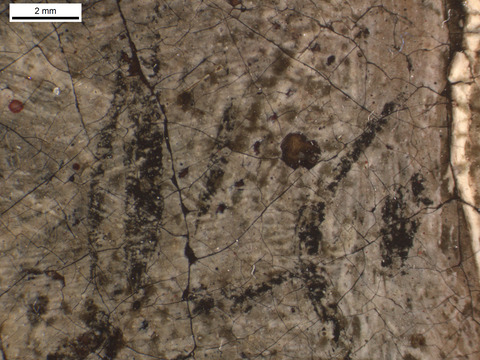
Condition of Paint
Although the extent of damage is difficult to determine due to extensive retouching, the paint layers are considerably abraded and worn, particularly in the background. Both the X-radiograph and the infrared reflectogram (tech. fig. 31) show considerable damages to the paint layer. A micro-cracking pattern from natural aging extends over the entire painting. Small paint losses are scattered throughout the painting. Some wear is visible around the perimeter of the painting where the paint is in contact with the frame. Some of the paint has been heavily abraded from a previous cleaning. This is evident in the writing, which unfortunately has become illegible.
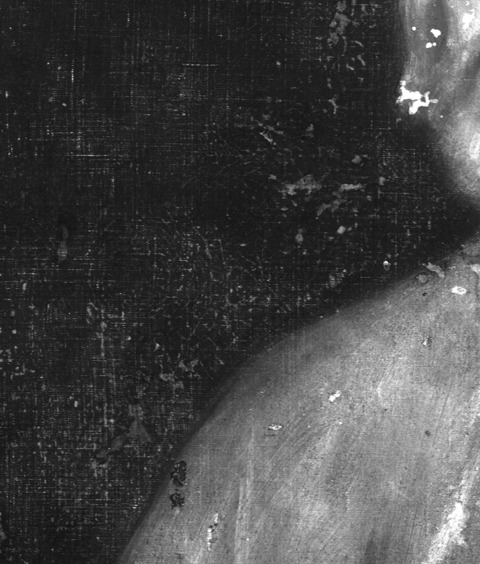
Description of Varnish/Surface Coating
Analyzed Observed Documented
| Type of Varnish | Application |
|---|---|
| Natural resin | Spray applied |
| Synthetic resin/other | Brush applied |
| Multiple Layers observed | Undetermined |
| No coating detected |
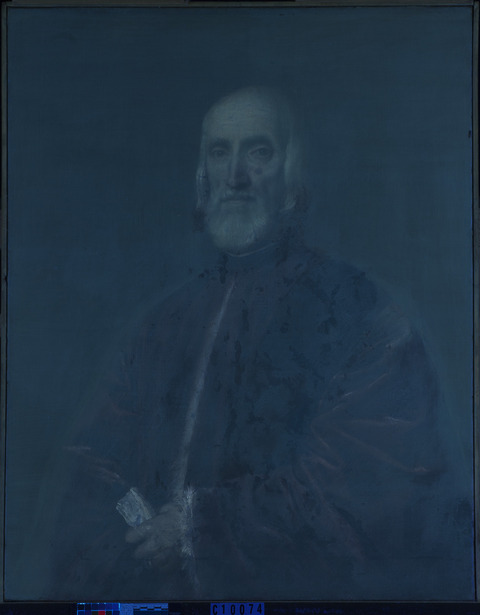
Ultraviolet-induced visible fluorescence reveals a coating of natural resin varnish present over the entire surface of the painting (tech. fig. 32). The painting appears to be slightly yellowed due to this aged layer. There are several campaigns of retouching present from an older restoration, as well as that of a more recent inpainting campaign.
Condition of Varnish/Surface Coating
The natural resin varnish is discolored. The painting remains saturated although removal of the varnish would certainly improve the appearance; however, this would likely remove the extensive retouching present. A few small scuffs and minor losses are visible, particularly around the perimeter where the painting is in contact with the frame but otherwise the varnish is intact. Surface dirt is present in small amounts throughout the painting. There are some areas of retouching visible under ultraviolet irradiation, and other older areas of overpaint visible under the microscope. There is some minor scratching in the varnish layer, likely from handling or framing, but this does not affect the paint layer.
Description of Frame
Original/first frame
Period frame
Authenticity cannot be determined at this time/ further art historical research necessary
Reproduction frame (fabricated in the style of)
Replica frame (copy of an existing period frame)
Modern frame
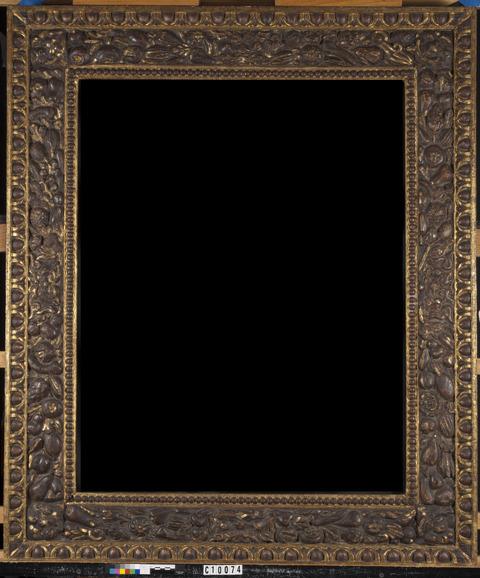
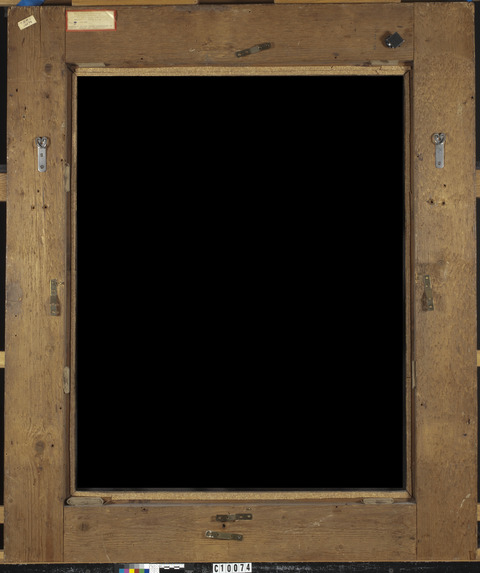
Frame Dimensions:
Outside frame dimensions: 113.3 × 95.3 cm
Distinguishing Marks:
None
Description of Molding/Profile:
The frame appears to be in the style of a Venetian Renaissance frame with a pearled inner edge and a fluted egg and dart ornament in the molding. The frieze is decorated with tumbling fruit elements. The entire frame is gilt, and elements are toned with reddish-brown paint. The corners are mitered from the front, but the wood buildup on the reverse has a butt joint.
Condition of Frame
The frame is in relatively good condition. There are some deeper cracks in the gesso layer, particularly at the corners and along the lower edge. Small losses are present throughout, and some general wear is visible.
Notes
-
Letter from William Suhr to Mrs. G.H.A. Clowes, 11 January 1960; Action approved by A.W. Clowes, 14 January 1960. Clowes Registration Archive, Indianapolis Museum of Art at Newfields. ↩︎
-
Letter from Daniel Goldreyer to Mrs. G. H. Clowes, 21 April 1964, with a note that the invoice was paid 13 October 1964. Clowes Registration Archive, Indianapolis Museum of Art at Newfields. ↩︎
-
Paul A.J. Spheeris, “Conservation Report on the Condition of the Clowes Collection,” 25 October 1971, Conservation Department Files, Indianapolis Museum of Art at Newfields. ↩︎
-
Martin Radecki, Clowes Collection condition assessment, undated (after October 1971), Conservation Department Files, Indianapolis Museum of Art at Newfields. ↩︎
-
Intermuseum Conservation Association, “Clowes Collection Conservation Report,” C10074 (2016.166), 8–10 April 1974, Conservation Department Files, Indianapolis Museum of Art at Newfields. ↩︎
-
Memorandum from Carl J. Weinhardt to Martin J. Radecki, “Charges for Conservation of Objects in the Clowes Collection,” 15 February 1974, Conservation Department Files, Indianapolis Museum of Art at Newfields. ↩︎
-
Memorandum from Martin Radecki to Bret Waller, “Conservation Work on Clowes Fund Collection,” 16 February 1996, Conservation Department Files, Indianapolis Museum of Art at Newfields. ↩︎
-
Richard Buck, Stretcher Design: A Brief Preliminary Survey (Oberlin, Ohio: Intermuseum Laboratory, Allen Art Building, 1972), Stretcher type 2b. ↩︎
-
Jill Dunkerton and Marika Spring, “The Development of Painting on Colored Surfaces in 16th C Italy,” in Painting Techniques, History, Materials, and Studio Practice, Contributions to the Dublin Congress, 7–11 September 1998, IIC, 120–135, 126. ↩︎
-
Findings were compared to those in Jill Dunkerton et al., “Titian’s Painting Technique from 1540,” National Gallery Technical Bulletin 36 (2015), and Jill Dunkerton et al., “Titian’s Painting Technique before 1540,” National Gallery Technical Bulletin 34 (2013). ↩︎
Additional Images
